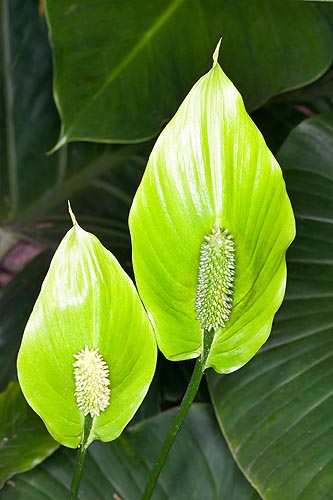Family : Araceae

Text © Pietro Puccio

English translation by Mario Beltramini

Little spread plant with unusual green spathe © Mazza
The name of the genus is the combination of the Greek words “spatha” = spathe, and “phyllon” = leaf, with reference to the spathe of the inflorescence, resembling to a leaf.
The name of the species is the Latin term “blandum” = attractive, pleasant.
Evergreen, acaulescent, herbaceous plant, it presents elliptic-oblong leaves, 20-35 cm long and 10-20 cm broad, on thin petioles, 20-40 cm long. The inflorescence is formed by a spathe with the shape of a leaf, with a sharp apex, long about 18 cm and 6-8 cm broad, of a pale green colour and by a cream-white spadix, 5-8 cm long.
The flowers are protogynous (the stigma, the female part, is receptive before the stamina ripe, thus avoiding auto fertilization), hermaphrodite. The fruits are berries containing oblong seeds almost kidney-form. It reproduces by seed and by division.
Plant not much spread around, it is cultivable in open air in tropical and humid subtropical climate zones, in shady position, elsewhere, it must be cultivated in pot on ventilated substrata, draining and rich of organic substance and is to be placed in diffused light, the direct sun can cause harm to the leaves, and without draughts; the temperatures are to be kept over the 16°C, best around 20-24°C, without sudden variations.
Watering must be frequent, always avoiding water stagnations which can generate rottenness, with the substratum never dried up completely; the ambient humidity, if in presence of dry air and high temperatures, can be, if it’s the case, incremented with nebulisation with water at room temperature and not calcareous, in order not to cause anti-aesthetic dots on the leaves.
All the parts of the plant contain toxic substances, in particular calcium oxalate, which can cause irritations.
